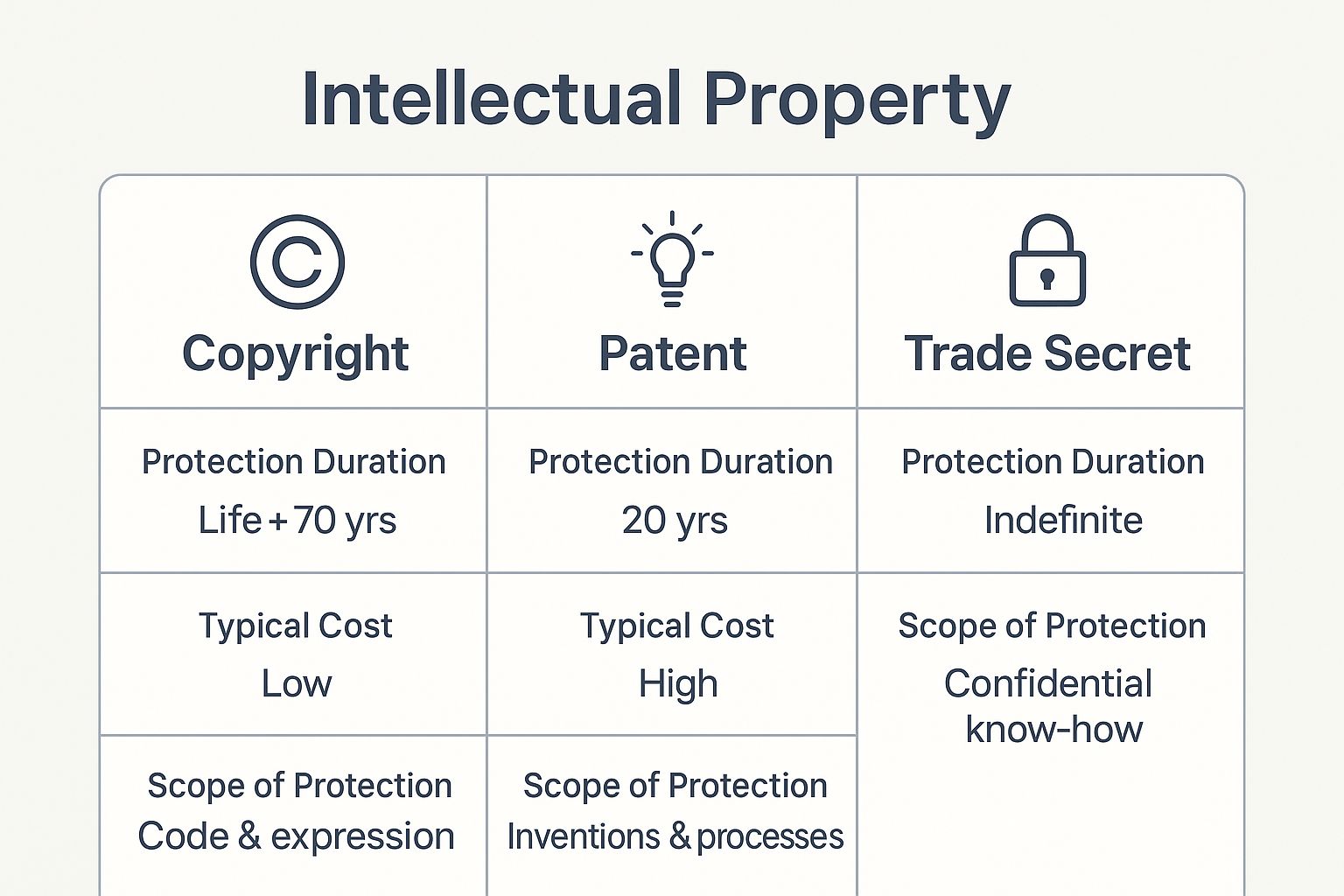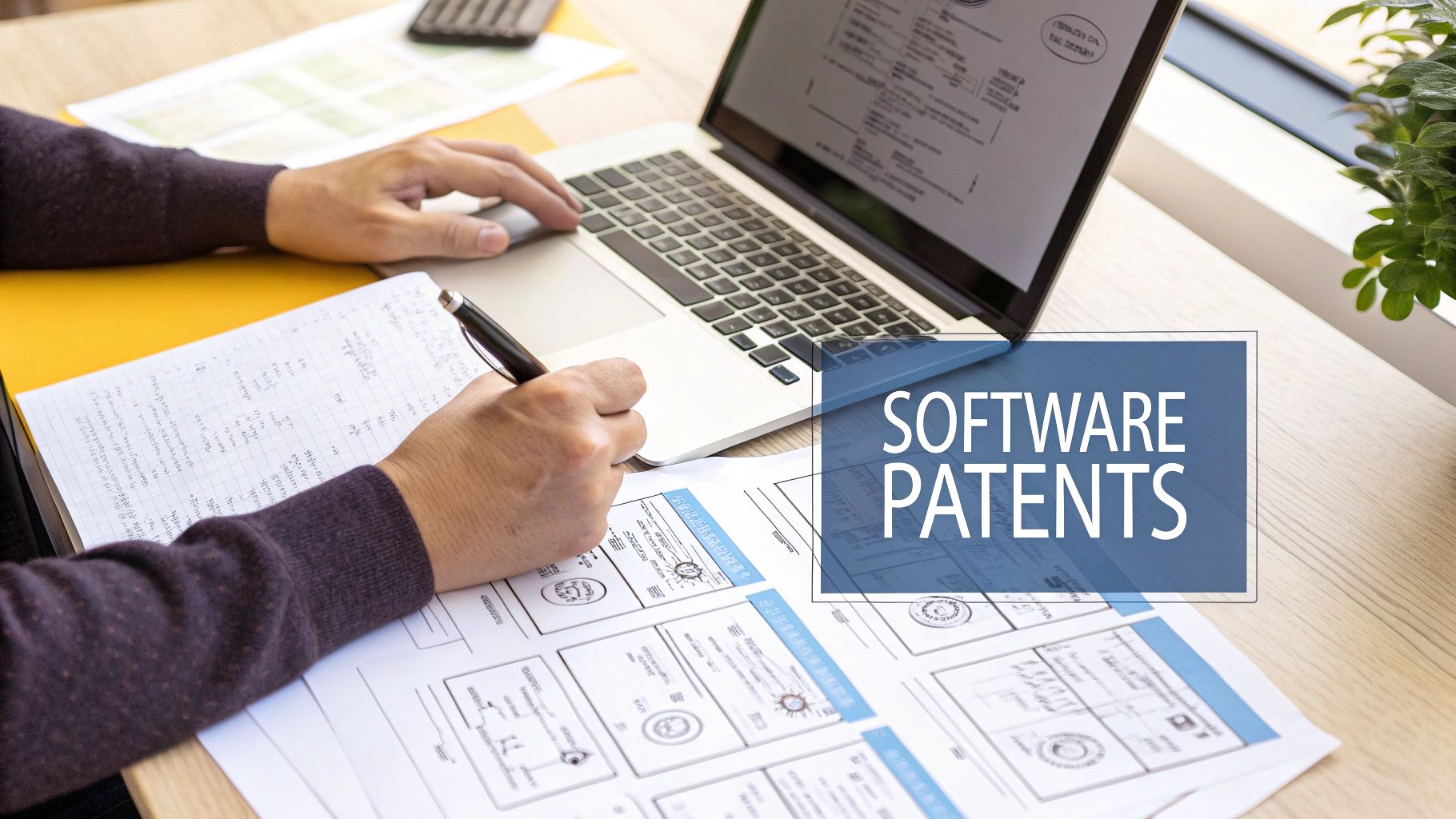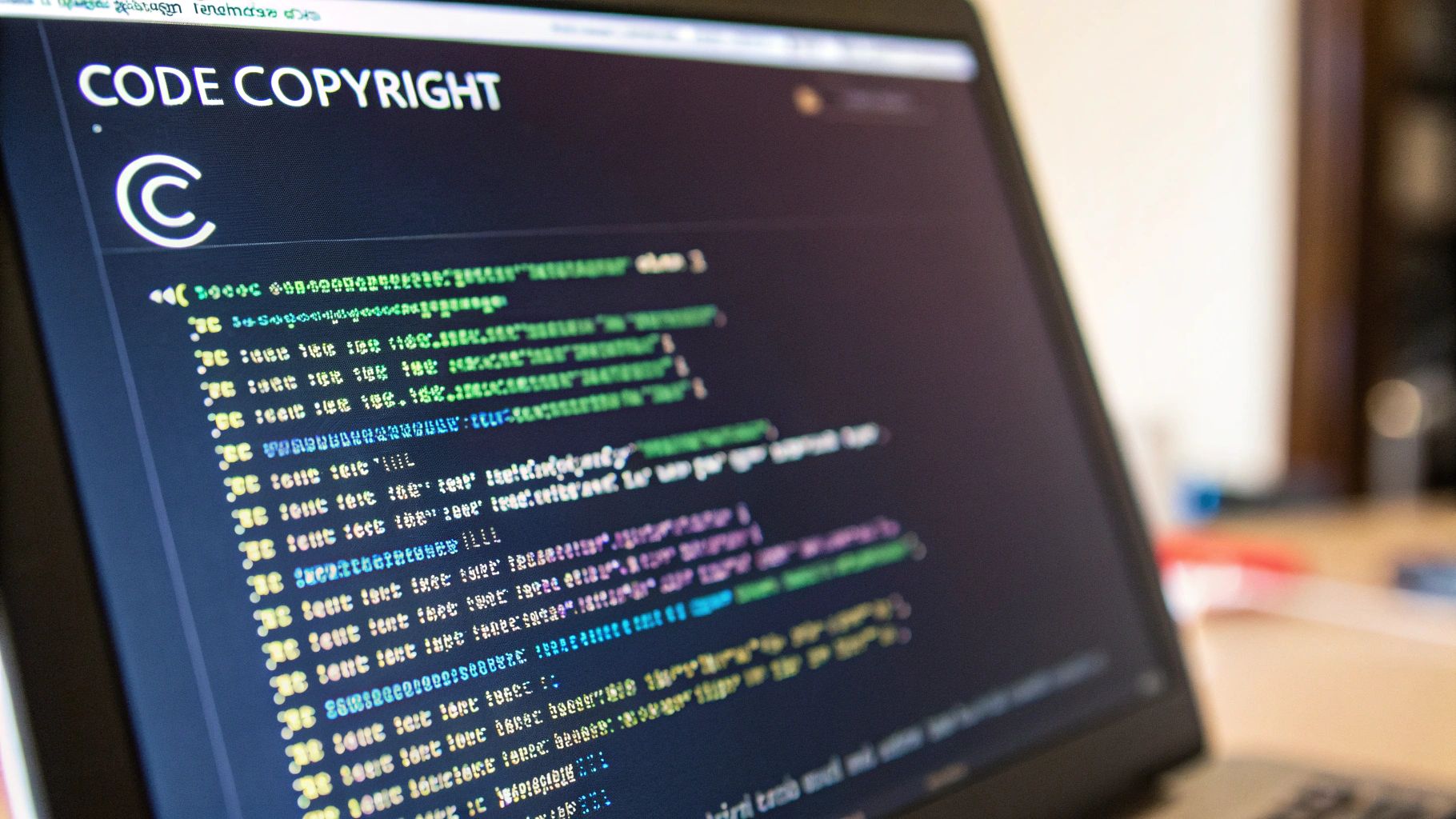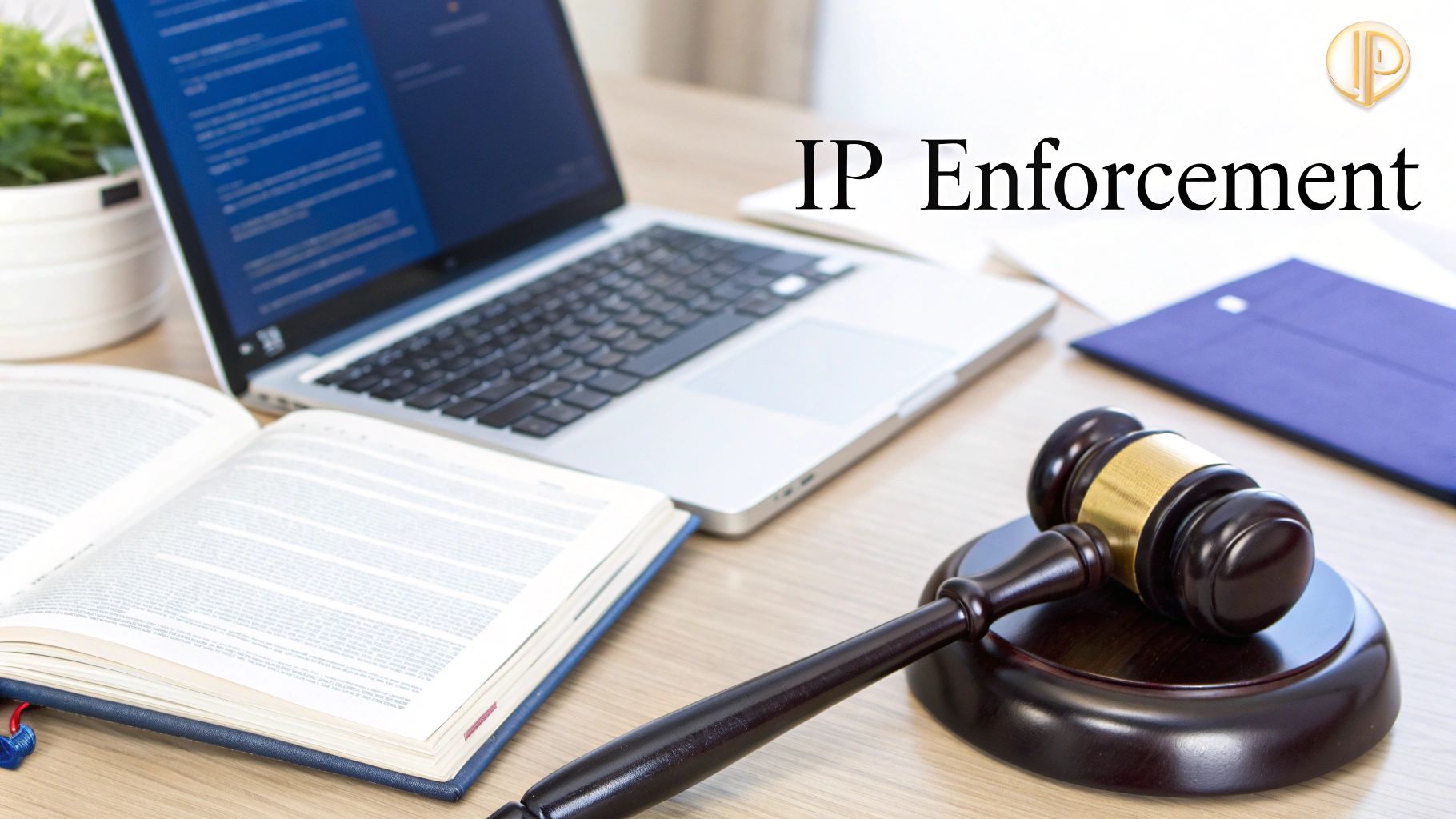The Messy Reality Of Software IP Protection
Navigating intellectual property in software often feels confusing. I’ve seen developers and founders stumble over patents, copyrights, trade secrets, and trademarks. The legal field can add to the confusion by using jargon and charging high fees. That’s why conversations about IP can bring work to a standstill.
- Patents: Protect novel functionalities and technical solutions
- Copyrights: Secure your expression in code the moment it’s written
- Trade Secrets: Shield confidential algorithms or processes indefinitely
- Trademarks: Guard your brand names, logos, and unique identifiers
Treat these categories like separate tools in a cluttered toolbox. Each plays a different role and relies on its own rules.
Many developers focus on patents, often on someone’s advice. Meanwhile, copyright protection starts automatically when code is created and lasts life plus 70 years. In fact, worldwide patent filings grew by 2.7% in 2023, reaching 3.6 million filings. Discover more insights about patent trends here. This increase shows the importance of a balanced IP approach.
Different Protections, Different Goals
If you aim to protect core functionality, patents make sense. To secure your brand, you look at trademarks instead. And your unique algorithms? That’s where trade secrets come in. Remember, each form of IP serves a distinct purpose, and they aren’t interchangeable.
Should You Even Bother Patenting?
Do you invest in a formal patent or rely on execution and secrecy? The answer depends on your product timeline, budget, and market. In some cases, moving quickly to market outperforms a lengthy patent process. We’ll explore the real costs and benefits of software patents next.
Software Patents: Worth the Time and Money?

Below is a data chart visualizing how software patents and copyrights compare on upfront costs and protection duration.
This bar chart shows that patents demand around $25K upfront plus ongoing fees for a 20-year term, while copyrights cost under $60 and last for life + 70 years, highlighting a clear trade-off.
Look, patenting software often feels like buying a bulletproof vest made of paper. After the Supreme Court’s Alice decision, abstract ideas alone won’t cut it—you need concrete technical details. Choosing to file a patent is a business decision as much as a legal checkbox. Consider whether exclusivity truly moves the needle for your startup.
Before you call a BigLaw partner who treats patents as a cash cow, ask yourself two questions:
- Do you need market exclusivity in a crowded field?
- Would a faster launch and minimal legal hurdles beat a 2-year exam process?
Patents vs. Copyrights for Software Protection
This table compares the key differences between patent and copyright protection for software, including what each protects, duration, costs, and strategic considerations:
| Protection Feature | Patents | Copyrights |
|---|---|---|
| What It Protects | Functional methods and innovations | Expression of code |
| Duration | 20 years from filing | Author’s life + 70 years |
| Average Cost | $20K–$30K+ (prep, filing, prosecution) | $0–$65 (online registration fees) |
| Strategic Use Case | Market exclusivity, investor signaling | Automatic deterrent, source code controls |
In summary, patents offer exclusive rights but require significant investment and a limited term, whereas copyrights deliver long-lasting protection at minimal cost.
Real-World Scenarios
- You’ve built a novel machine-learning feature: a patent can attract venture capital.
- You run a nimble SaaS app: speed to market often outperforms a lengthy prosecution.
- You hold algorithms suited for secrecy: trade secrets may be the smarter path.
Many in the legal industry push patents because that’s where the fees lie. But a patent that never issues or fails the Alice test can cost you $20K+ with zero protection. Is exclusivity worth the gamble?
Next, we’ll explore when hiding your code as a trade secret makes more sense than formal filings.
Open Source: The IP Landmine Nobody Talks About

Open source often seems like a free lunch—until you read the fine print. I’m a big fan of community-driven code, but when it comes to intellectual property, those licenses can hit hard. Ignoring terms risks turning proprietary work into public domain and costing you millions in lost deals and developer trust.
Why Licenses Matter
Take the GPL license: its copyleft clause forces you to share any code that links to it. Include a GPL library in your project and you might have to publish your entire codebase. It’s like borrowing a neighbor’s lawnmower—and ending up obliged to let them use your entire garage.
How To Spot License Landmines
- Automate Scans with tools like FOSSA and WhiteSource
- Flag Strong Copyleft licenses: GPL, AGPL, LGPL
- Monitor Viral Clauses that trigger on distribution
- Audit Hidden Code from freelancers or undocumented modules
License Risk Comparison
| License Type | Copyleft Level | Key Risk |
|---|---|---|
| MIT | Permissive | Minimal; attribution only |
| Apache 2.0 | Permissive + patent grant | Patent retaliation clauses |
| GPL v3 | Strong Copyleft | Must release derivative works |
| AGPL v3 | Network Copyleft | Applies to SaaS (web) deployments |
This table gives a quick overview of the main hazards in each license family.
Building Governance That Works
A solid governance plan keeps teams agile without risking compliance.
- Establish Clear Policies to define approved licenses and use cases
- Add License Checks into your CI/CD pipeline
- Train Teams on which licenses are allowed and which are off-limits
- Maintain an Open Channel for emergency fixes and refactoring
Ignoring open source terms can sink an acquisition or funding round. Treat every license like a binding contract to avoid unexpected legal shocks.
Next, we’ll explore how to safeguard trade secrets without turning your office into a fortress.
Going Global: Navigating International Software IP

Expanding your software patent beyond home turf without a clear plan can lead to wasted resources and unexpected hurdles. What works in the US often fails in Europe, and China’s procedures can catch newcomers off guard. Filing everywhere by default isn’t just costly—it can distract you from key markets.
Why Filing Everywhere Is a Bad Idea
Before you commit to filings in dozens of countries, pick the protections that suit your product and budget:
- PCT Strategy: File one application, then choose target nations
- Priority Claims: Secure your original filing date in multiple regions
- Copyright Reliance: Leverage automatic code protection where available
- Trade Secret Focus: Keep proprietary algorithms confidential
You don’t need venture-level budgets to protect your software. In fact, the global software IP protection market hit $7.5 billion in 2022 and is projected to reach $31.3 billion by 2032 at a 15.6% CAGR. Learn more in this Allied Market Research report
The Patchwork Table
| Jurisdiction | Patent Threshold | Enforcement Ease | Typical Strategy |
|---|---|---|---|
| USA | Broad (“any technical art”) | High cost, complex | Large filings, cautious of Alice rules |
| EU | “Technical effect” required | Moderate, slow | Combine copyright and design claims |
| China | Vague subject matter rules | Varies by province | Co-file with a local partner |
Okay, Let’s Talk PCT
A PCT application gives you extra time—and a fixed deadline—to evaluate where protection truly matters. Sometimes chasing new patents makes less sense than investing in market rollout.
- File your PCT application
- Compare estimated costs with market potential
- Enter national phases in top-priority countries
- Refine your approach based on initial feedback
IP strategy rarely follows a neat checklist. You’ll adjust as you go and learn which filings deliver real value.
The key takeaway? Balance your filings, learn local nuances (yes, even when you face Chinese patent trolls), and focus on what protects your bottom line—not just what keeps law firms busy.
Trade Secrets: The Unsung Hero Of Software Protection
When it comes to intellectual property for software, patents often steal the spotlight. Many teams rush to file applications and spell out every detail. But sometimes, keeping your methods under wraps offers a stronger line of defense. After all, why share your secret sauce in public filings when you can simply keep it hidden?
In 2024, the global intellectual property management software market reached USD 12.30 billion in value. Analysts project a 12.9% CAGR from 2025 to 2030, as more organizations realize the value of robust IP programs. This trend underscores the need for solid systems to protect your proprietary code and processes. For a deeper dive, check out the IP management software growth report.
Reasonable Measures For Protection
Courts expect more than a “Confidential” stamp. You must prove that your workflows and algorithms are treated like crown jewels. Skipping these basics makes proving misappropriation nearly unavoidable:
- NDAs with anyone who sees your code
- Access Controls to lock down servers and repositories
- Employee Training on what counts as a secret
- Offboarding Procedures to reclaim badges and tokens
- Documented Policies that outline every step
Strengthening Your Offboarding Process
Exits aren’t just awkward conversations—they’re potential risk points. At Cordero Law, we make sure departing staff:
- Sign or reaffirm their NDAs
- Return key cards, badges, and devices
- Lose access to GitHub and cloud platforms
- Confirm receipt of final confidentiality reminders
It may sound thorough, but when someone walks out with your roadmap, you’ll appreciate the rigor.
A Quick Reality Check
Many developers assume IP theft only happens in thrillers. In fact, it occurs daily—often via trusted contractors or employees who underestimate the impact of a simple copy-and-paste.
Secrecy Measures At A Glance
| Measure | Effort Level | Risk if Ignored |
|---|---|---|
| NDAs | Low | High |
| Access Controls | Medium | Moderate |
| Employee Training | Medium-High | Significant |
| Offboarding Process | High | Critical |
Key Takeaways
- Trade Secrets can outlast patents when you back them with proof of protection
- Documentation is your strongest ally in court
- People Processes (training and offboarding) matter as much as technical safeguards
When Someone Steals Your Code: Enforcement Realities
Enforcement can be a major burden if your budget is limited. Most startups face litigation bills that slip into the seven-figure range, and that’s before discovery expenses. Still, you don’t have to mortgage your future to defend your work. There are practical steps you can take to address infringements without overextending your resources.
Letters, Licenses, and Other Tactics
A cease and desist letter is often your first line of defense. It shows the infringer you mean business and gauges their willingness to cooperate.
- Draft a letter that’s firm but not hostile (tone is critical).
- Reference specific code snippets or version-control timestamps.
- Set a clear deadline, typically seven to ten days.
Law firms will rack up hours on letters that go nowhere. At Cordero Law, we aim for enough pressure to get a response without making headlines.
Turning Infringement Into Income
In some cases, a licensing deal is more efficient than a court battle. License negotiations can:
- Generate upfront revenue with lower legal fees
- Tie usage fees to customer metrics (for example, per-user or per-API call)
- Lay the groundwork for ongoing IP collaborations
Adopting a selective enforcement strategy means focusing on the one case most likely to impact your bottom line or set a useful precedent.
Monitoring Your Code
A solid monitoring plan is essential. Decide between manual review, automated scanning, or a hybrid approach.
- Automated tools catch 70% of direct clones but may miss obfuscation
- Manual audits spot subtle changes but consume developer hours
- Hybrid approach: schedule weekly scans and investigate any flags
Below is an overview of software IP enforcement options.
Software IP Enforcement Options
This table outlines different enforcement strategies for software intellectual property violations, with typical costs, timelines, and success factors
| Enforcement Method | Typical Cost Range | Timeline | Success Factors | Best Used When |
|---|---|---|---|---|
| Cease & Desist Letter | $500–$2K | 1–3 weeks | Clear evidence, firm tone | Early infringement; test the waters |
| License Negotiation | $5K–$20K+ | 2–8 weeks | Fair terms, solid metrics | Monetizable reuse; cooperative infringer |
| Litigation | $100K–$1M+ | 6–24 months | Case strength, funding support | High-stakes disputes; precedent value |
| Alternative Dispute | $20K–$100K | 3–6 months | Skilled mediator, clear goals | Confidential cases; faster resolution |
Each option carries its own trade-offs in cost, time, and complexity. This breakdown helps you weigh each method against your resources and risk tolerance.
When To Bring In Outside Help
You might be able to manage enforcement in-house, but consider external counsel if:
- Your team lacks IP litigation experience
- Key deadlines are approaching or you face parallel patent actions
- You prefer to avoid public filings (such as IPR or nullity proceedings)
You don’t always need top-tier litigators from day one. Build internal confidence and then engage specialized help—such as Cordero Law—when it makes business sense.
Next, we’ll develop an IP strategy that aligns with your growth plan and runway.
Building an IP Strategy That Actually Makes Sense

Now let’s bring everything together—no one-size-fits-all checklists. We frame your IP playbook around clear business goals. Sometimes trade secrets are the smart choice. Other times patents or copyrights provide the right shield.
Here’s why there is no universal recipe for software protection. Many lawyers treat IP as a mere formality, but it should support how you operate. Think of it like choosing hiking boots: the wrong fit can leave you injured or stuck.
Your IP Playbook
- Define Clear Objectives
- Exit Strategy vs. Organic Growth
- Enterprise Sales vs. Consumer Buzz
- Match Protections to Goals
- Patents for funding rounds
- Trade Secrets for core algorithms
- Copyrights for code expression
- Allocate a Realistic Budget
- Prioritize low-cost, high-impact actions
- Reserve funds for enforcement or extensions
Questions remain on cost, internal bandwidth, and maintenance fees. You might wonder when to switch course. At some point you simply need to act.
Quick Cost vs. Benefit Glance
| Protection Type | Typical Cost | Timeline | When to Use |
|---|---|---|---|
| Patent | $15K–$30K+ | 2–4 years | When investors need tech exclusivity |
| Trade Secret | $2K–$10K | Immediate | For proprietary workflows no one copies |
| Copyright | < $100 | Instant | Always, as it applies automatically |
Those rough edges are by design—real choices rarely feel tidy.
- Draft your goal statement
- File when it matters (or skip if not)
- Secure your secret sauce
It’s not glamorous or predictable, but it’s actionable.
Many treat IP as a cash generator. We at Cordero Law prefer practical advice over theory.
Ready to build an IP plan that drives value? Contact us—Cordero Law hires you, not bills you.
Get started now: Cordero Law Group
